Reasonable Paths of Construction Ventilation for Large-Scale Underground Cavern Groups in Winter and Summer
Abstract
:1. Introduction
2. Project Overview
2.1. Layout of Underground Structures
2.2. Principle of Natural Ventilation
2.3. Ventilation Scheme
3. Field Test
4. Computational Model
4.1. Model Description
4.2. Setting the Boundary
4.3. Validation with Field Ventilation Test Data
5. Results and Discussion
5.1. Ventilation Effect in the Summer Ventilation Scheme
5.2. Axial Fan Arrangement at the Shaft Bottom
5.3. Ventilation Effect of the Winter Ventilation Scheme
5.4. Influence of Temperature Difference on Natural Ventilation
6. Conclusions
Author Contributions
Funding
Acknowledgments
Conflicts of Interest
References
- Lin, F.; Ren, F.; Luan, H.B.; Ma, G.W.; Chen, S.G. Effectiveness Analysis of Water-sealing for Underground LPG Storage. Tunn. Undergr. Space Technol. 2016, 51, 270–290. [Google Scholar] [CrossRef]
- Gao, X.; Yan, E.C.; Yeh, T.C.J.; Wang, Y.L.; Liang, Y.; Hao, Y.H. Reliability analysis of hydrologic containment of underground storage of liquefied petroleum gas. Tunn. Undergr. Space Technol. 2018, 79, 12–26. [Google Scholar] [CrossRef]
- Liu, J.; Zhao, X.D.; Zhang, S.J.; Xie, L.K. Analysis of support requirements for underground water-sealed oil storage cavern in China. Tunn. Undergr. Space Technol. 2018, 71, 36–46. [Google Scholar] [CrossRef]
- Hong, K.R. Development and Application of Construction Technologies for Underground Water-sealed Energy Storage Caverns. Tunnel Constr. 2014, 34, 189–197. [Google Scholar] [CrossRef]
- Zhang, H.; Chen, S.G.; Yang, J.S. Ventilation Technology in Super Long Group Tunnelling with Trackless Transportation and No Outcrop. J. Saf. Environ. 2013, 13, 229–231. [Google Scholar] [CrossRef]
- Zhao, X.; Wang, R.K.; Zhang, W.H. Measures of Improving Ventilation Efficiency during Construction in Complex Caverns. J. Yangtze River Sci. Res. Inst. 2014, 8, 117–121. [Google Scholar] [CrossRef]
- Safety Operation Regulations for Tunnel Drilling and Blasting. Available online: http://www.safehoo.com/Rules/Traffic/201011/155705.shtml (accessed on 1 November 2010).
- Ministry of Communications of PRC. Technical Specifications for Construction of Highway Tunnel (JTG F60-2009); China Communications Press: Beijing, China, 2009.
- Ministry of Railways of PRC. Code for Construction on Tunnel of Railway (TB10204-2002); China Railway Publishing House: Beijing, China, 2002.
- Zhang, H.; Lin, F.; Zhang, K.; Yang, J.S.; Chen, S.G. Establishment of a Ventilation Network and the Shaft Ventilation Effect in a Large Underground Cavern Group. Mod. Tunn. Technol. 2018, 55, 203–209. [Google Scholar] [CrossRef]
- Kurnia, J.C.; Sasmito, A.P.; Mujumdar, A.S. Simulation of a Novel Intermittent Ventilation System for Underground Mines. Tunn. Undergr. Space Technol. 2014, 42, 206–215. [Google Scholar] [CrossRef]
- Parra, M.T.; Villafruela, J.M.; Castro, F.; Méndez, C. Numerical and Experimental Analysis of Different Ventilation Systems in Deep Mines. Build. Environ. 2006, 41, 87–93. [Google Scholar] [CrossRef]
- Toraño, J.; Torno, S.; Menéndez, M.; Gent, M. Auxiliary Ventilation in Mining Roadways Driven with Road Headers: Validated CFD modelling of dust behavior. Tunn. Undergr. Space Technol. 2011, 26, 201–210. [Google Scholar] [CrossRef]
- Diego, I.; Torno, S.; Toraño, J.; Menéndez, M.; Gent, M. A Practical Use of CFD for Ventilation of Underground Works. Tunn. Undergr. Space Technol. 2011, 26, 189–200. [Google Scholar] [CrossRef]
- Xia, Y.M.; Yang, D.; Hu, C.H.; Wu, C.Z.; Han, J.L. Numerical Simulation of Ventilation and Dust Suppression System for Open-type TBM Tunneling Work Area. Tunn. Undergr. Space Technol. 2016, 56, 70–78. [Google Scholar] [CrossRef]
- Torno, S.; Toraño, J.; Ulecia, M.; Allende, C. Conventional and Numerical Models of Blasting Gas Behaviour in Auxiliary Ventilation of Mining Headings. Tunn. Undergr. Space Technol. 2013, 34, 73–81. [Google Scholar] [CrossRef]
- Sasmito, A.P.; Birgersson, E.; Ly, H.C.; Mujumdar, A.S. Some approaches to improve ventilation system in underground coal mines environment—A computational fluid dynamic study. Tunn. Undergr. Space Technol. 2013, 34, 82–95. [Google Scholar] [CrossRef]
- Zhang, H.R.; Pera, L.S.; Zhao, Y.J. Researches and applications on geostatistical simulation and laboratory modeling of mine ventilation network and gas drainage zone. Process Saf. Environ. Prot. 2015, 94, 55–64. [Google Scholar] [CrossRef]
- Nakayama. In-situ measurement and simulation by CFD of methane gas distribution at a heading faces. Shigen-to-Sozai 1998, 114, 769–775. [Google Scholar] [CrossRef]
- Laslandes, S.; Sacé, C. Transport of particles by a turbulent flow around an obstacle—A numerical and a wind tunnel approach. J. Wind Eng. Ind. Aerodyn. 1998, 74–76, 577–587. [Google Scholar] [CrossRef]
- Klemens, R.; Kosinski, P.; Wolanski, P.; Korobeinikov, V.P.; Markov, V.V.; Menshov, I.S.; Semenov, I.V. Numerical Study of Dust Lifting in a Channel with Vertical Obstacles. J. Loss Prev. Process Ind. 2001, 14, 469–473. [Google Scholar] [CrossRef]
- Toraño, J.; Torno, S.; Menendez, M.; Gent, M.; Velasco, J. Models of methane behaviour in auxiliary ventilation of underground coal mining. Int. J. Coal Geol. 2009, 80, 35–43. [Google Scholar] [CrossRef]
- Fang, Y.; Fan, J.; Kenneally, B.; Mooney, M. Air Flow Behavior and Gas Dispersion in the Recirculation Ventilation System of a Twin-tunnel Construction. Tunn. Undergr. Space Technol. 2016, 58, 30–39. [Google Scholar] [CrossRef]
- Zhang, H.; Sun, J.C.; Lin, F.; Wang, L. Optimization on Energy Saving Ventilation of Gallery-type Combined Construction Shaft Exhaust in Extra Long Tunnel. Procedia Eng. 2017, 205, 1777–1784. [Google Scholar] [CrossRef]
- Liu, Z.; Wang, X.L.; Cheng, Z.F.; Sun, R.R.; Zhang, A.L. Simulation of Construction Ventilation in Deep Diversion Tunnels Using Euler–Lagrange Method. Comput. Fluids 2014, 105, 28–38. [Google Scholar] [CrossRef]
- Wang, X.; Liu, X.; Sun, Y.; An, J.; Zhang, J.; Chen, H.C. Construction Schedule Simulation of a Diversion Tunnel Based on the Optimized Ventilation Time. J. Hazard. Mater. 2009, 165, 933–943. [Google Scholar] [CrossRef] [PubMed]
- Liu, Y.C.; Wang, S.C.; Deng, Y.B.; Ma, W.W.; Ma, Y. Numerical simulation and experimental study on ventilation system for powerhouses of deep underground hydropower stations. Appl. Therm. Eng. 2016, 105, 151–158. [Google Scholar] [CrossRef]
- Lowndes, I.S.; Yang, Z.Y.; Jobling, S.; Yates, C. A parametric analysis of a tunnel climatic prediction and planning model. Tunn. Undergr. Space Technol. 2006, 21, 520–532. [Google Scholar] [CrossRef]
- Sa, Z.Y.; Li, F.; Qin, B.; Pan, X.H. Numerical simulation study of dust concentration distribution regularity in cavern stope. Saf. Sci. 2012, 50, 857–860. [Google Scholar] [CrossRef]
- Yoon, C.H.; Kim, M.S.; Jin, K. The evaluation of natural ventilation pressure in Korean long road tunnels with vertical shafts. Tunn. Undergr. Space Technol. 2006, 21, 472–477. [Google Scholar] [CrossRef]
- Guo, C.; Xu, J.; Yang, L.; Guo, X.; Zhang, Y.; Wang, M. Energy-saving network ventilation technology of extra-long tunnel in climate separation zone. Appl. Sci. 2017, 7, 454. [Google Scholar] [CrossRef]
- Li, A.G.; Gao, X.P.; Ren, T. Study on thermal pressure in a sloping underground tunnel under natural ventilation. Energy Build. 2017, 147, 200–209. [Google Scholar] [CrossRef]
- Mazarrón, F.R.; Amores, C.P.; Guerrero, I.C. Annual evolution of the natural ventilation in an underground construction: Influence of the access tunnel and the ventilation chimney. Tunn. Undergr. Space Technol. 2015, 49, 188–198. [Google Scholar] [CrossRef]
- Zhang, Z.Q.; Zhang, H.; Tan, Y.J.; Yang, H.Y. Natural wind utilization in the vertical shaft of a super-long highway tunnel and its energy saving effect. Build. Environ. 2018, 145, 140–152. [Google Scholar] [CrossRef]
- Wang, F.; Wang, M.N.; He, S.; Deng, Y.Y. Computational Study of Effects of Traffic Force on the Ventilation in Highway Curved Tunnels. Tunn. Undergr. Space Technol. 2011, 26, 481–489. [Google Scholar] [CrossRef]
- Wang, F.; Wang, M.N.; He, S.; Zhang, J.S.; Deng, Y.Y. Computational Study of Effects of Jet Fans on the Ventilation of a Highway Curved Tunnel. Tunn. Undergr. Space Technol. 2010, 25, 382–390. [Google Scholar] [CrossRef]
- Zhang, H.; Fang, L.; Sun, J.C.; Zhou, Z.L. CFD Analysis of Tunnel Construction Ventilation Effect Based on Typical Wall Roughness Model. China Railw. Sci. 2016, 37, 58–65. [Google Scholar] [CrossRef]
- Wu, Z.L. Ventilation in Heading Face after Blasting, 1st ed.; Metallurgical Industry Press: Beijing, China, 1959; pp. 1–3. [Google Scholar]
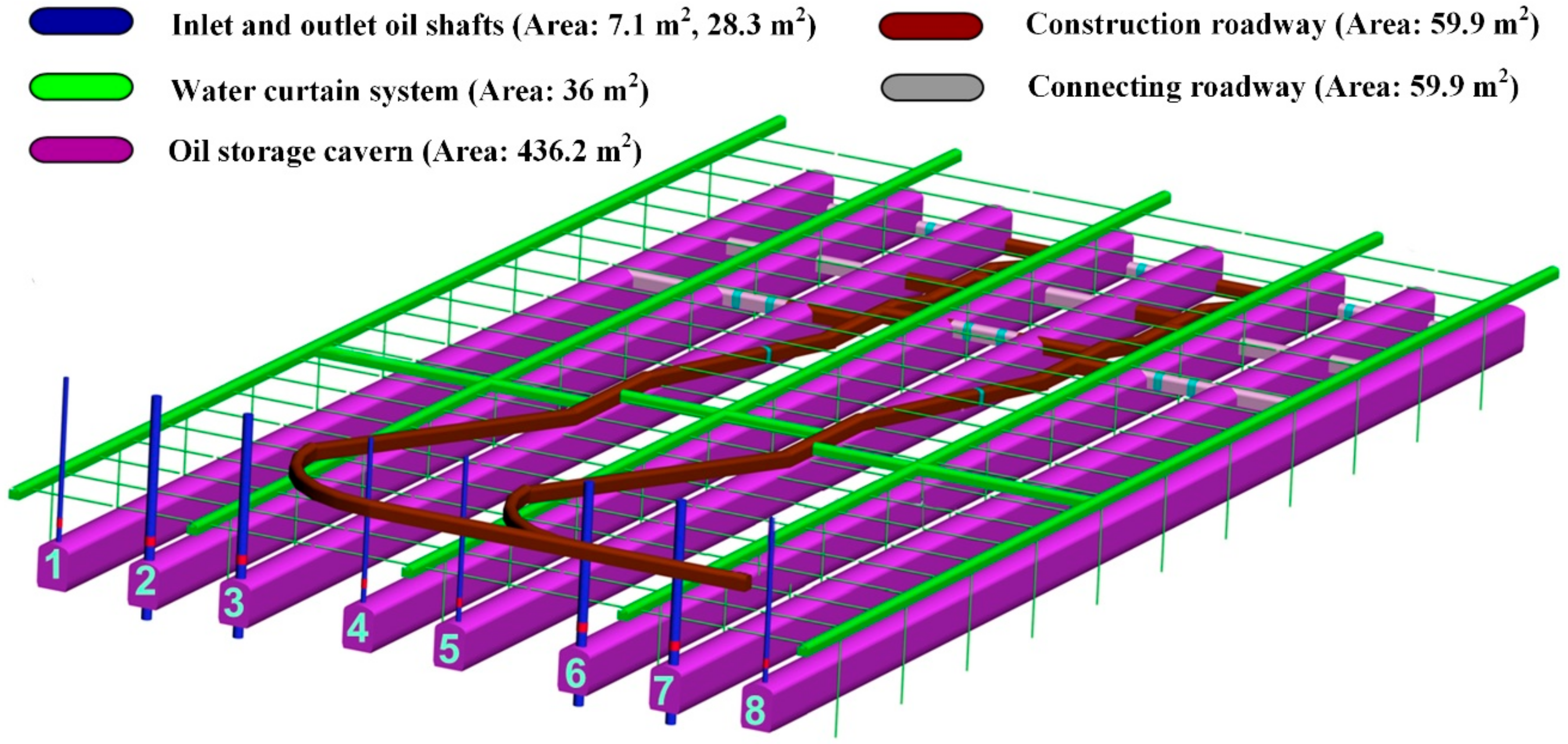
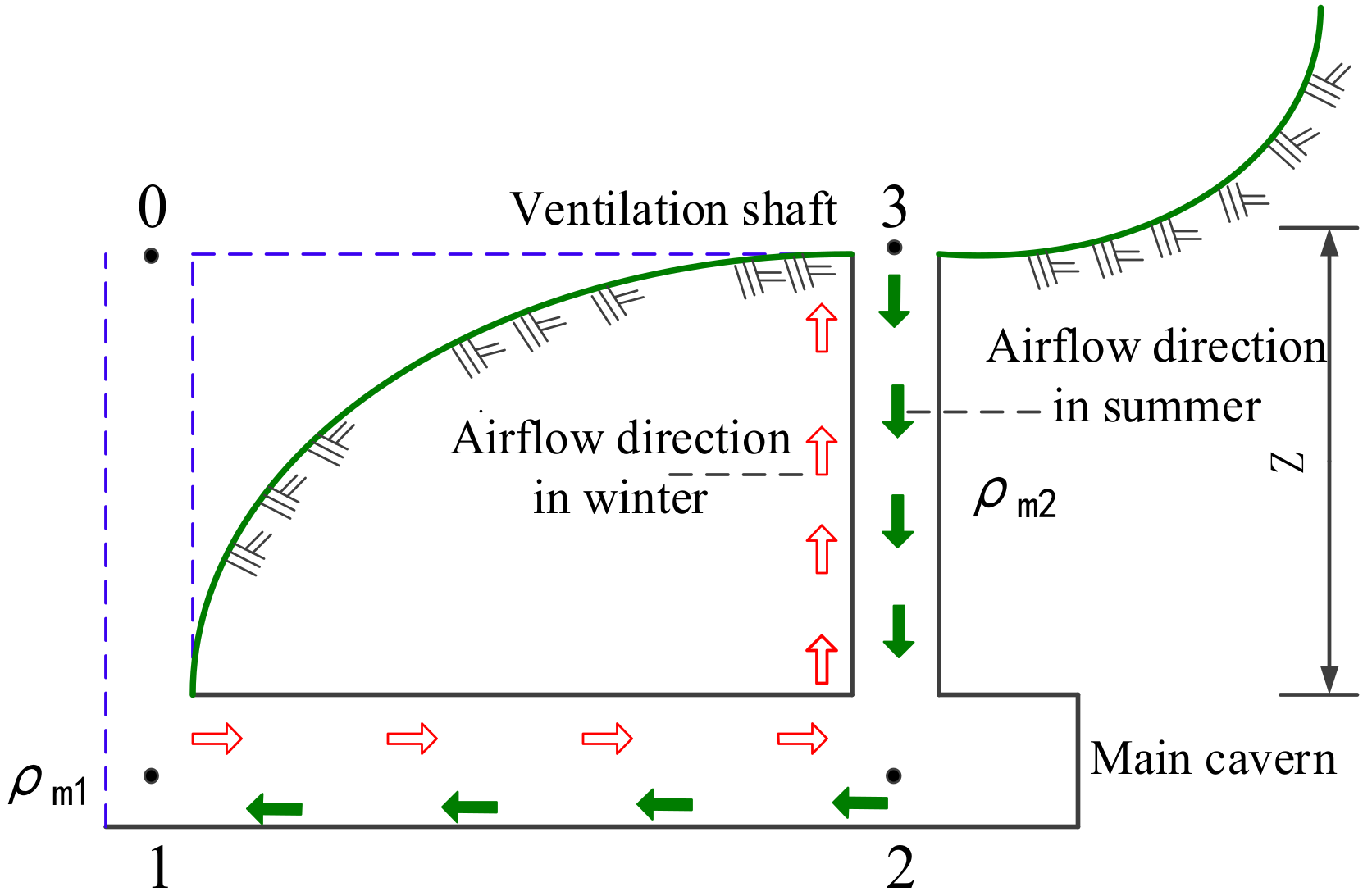

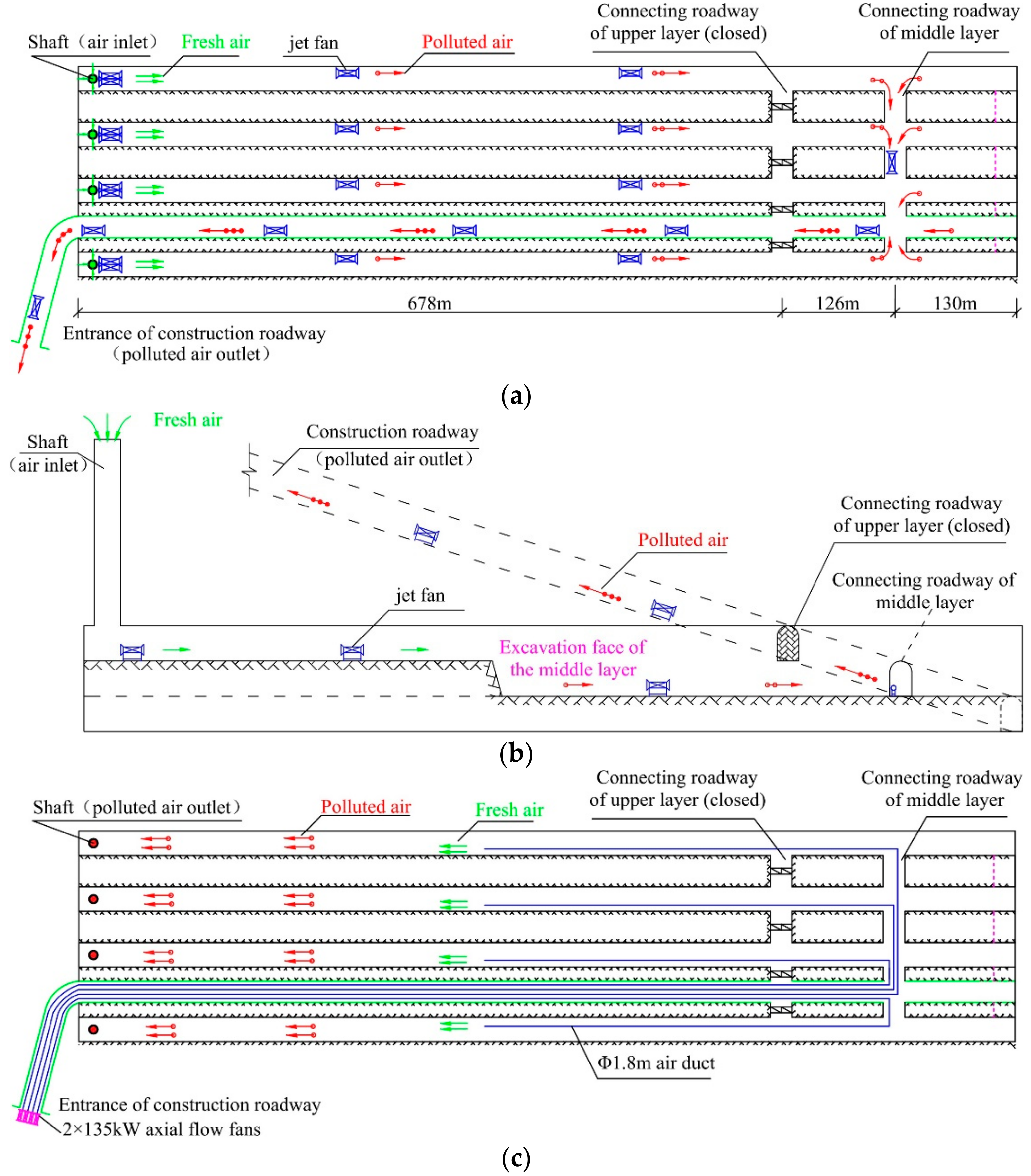
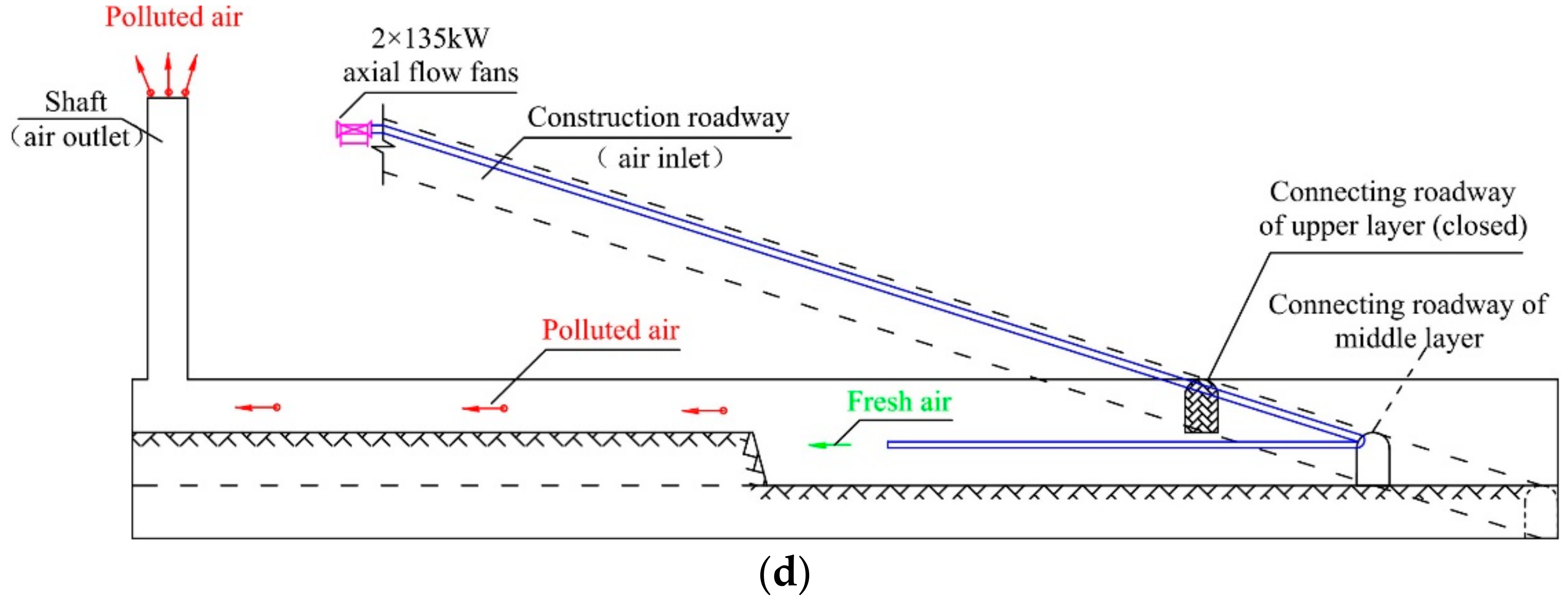
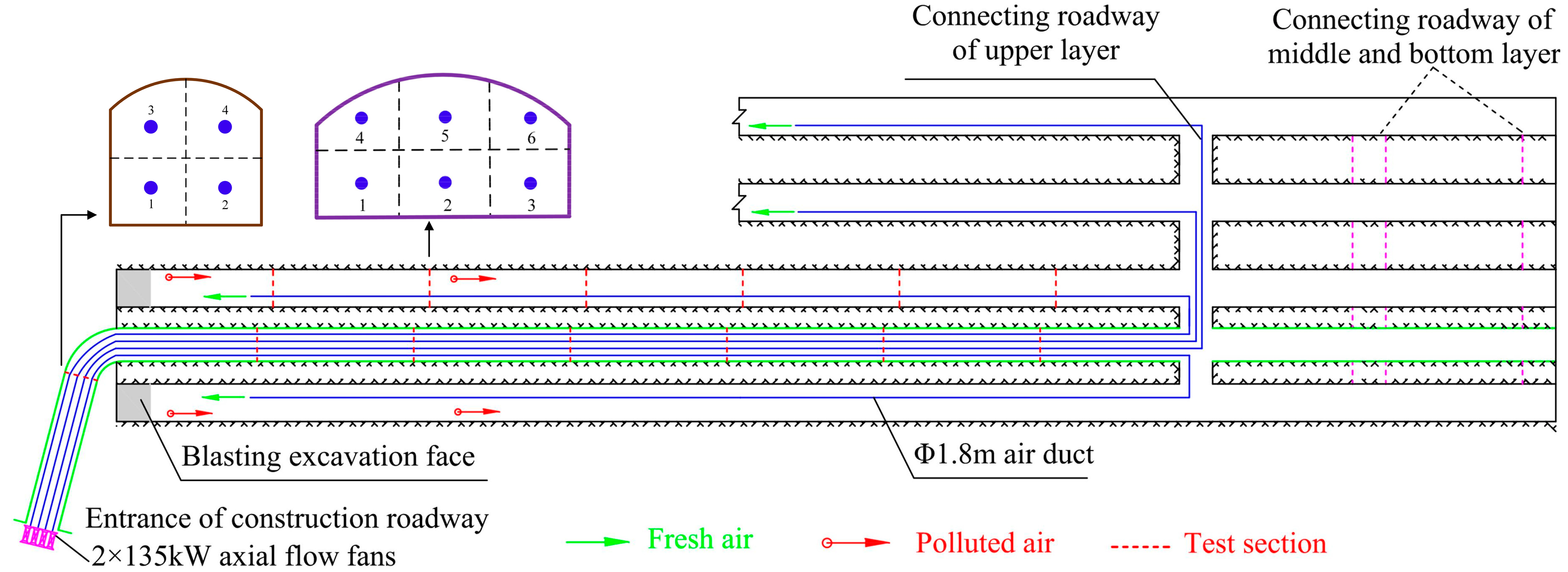

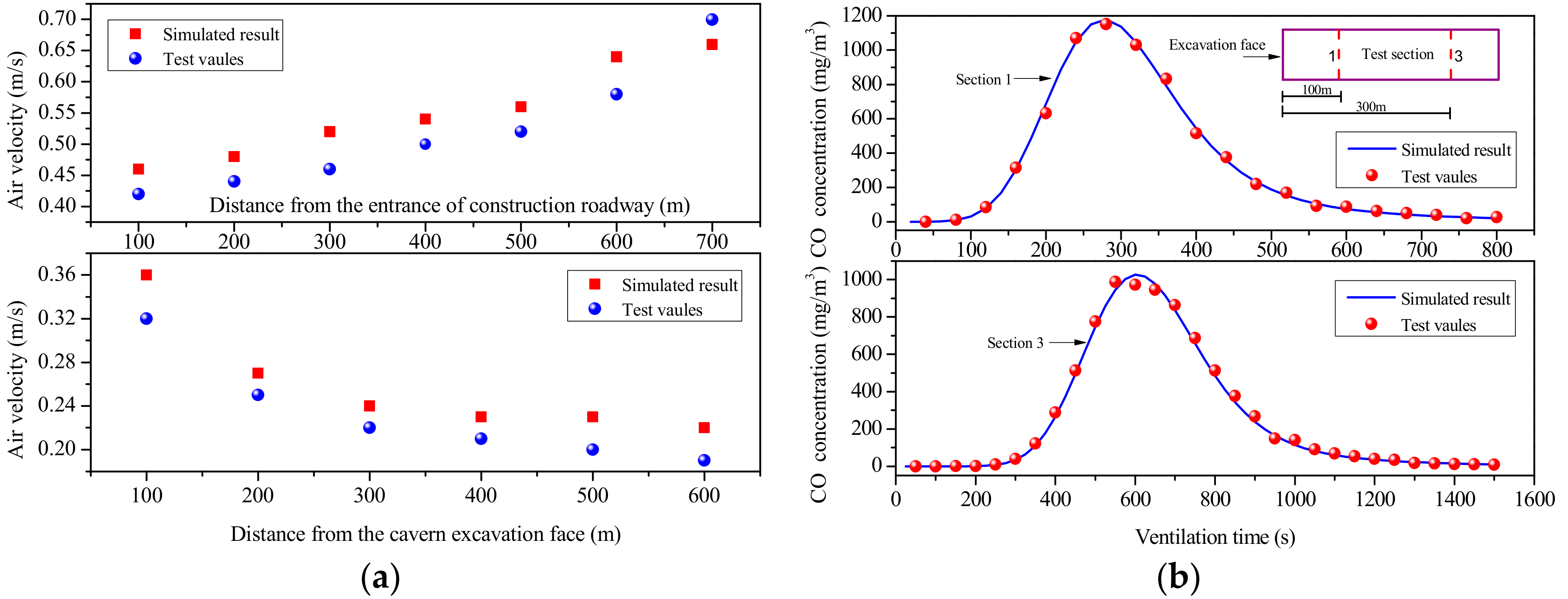
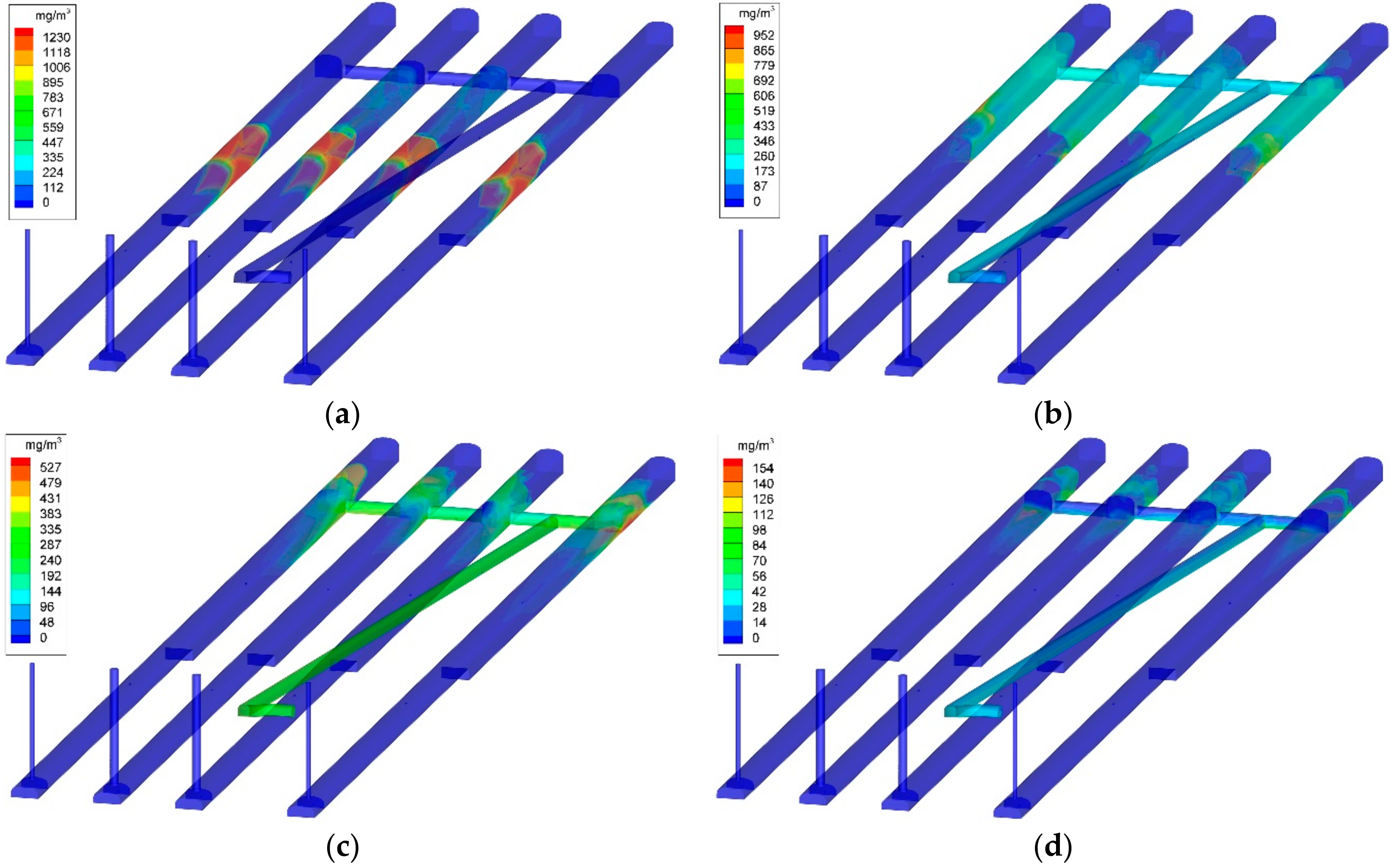
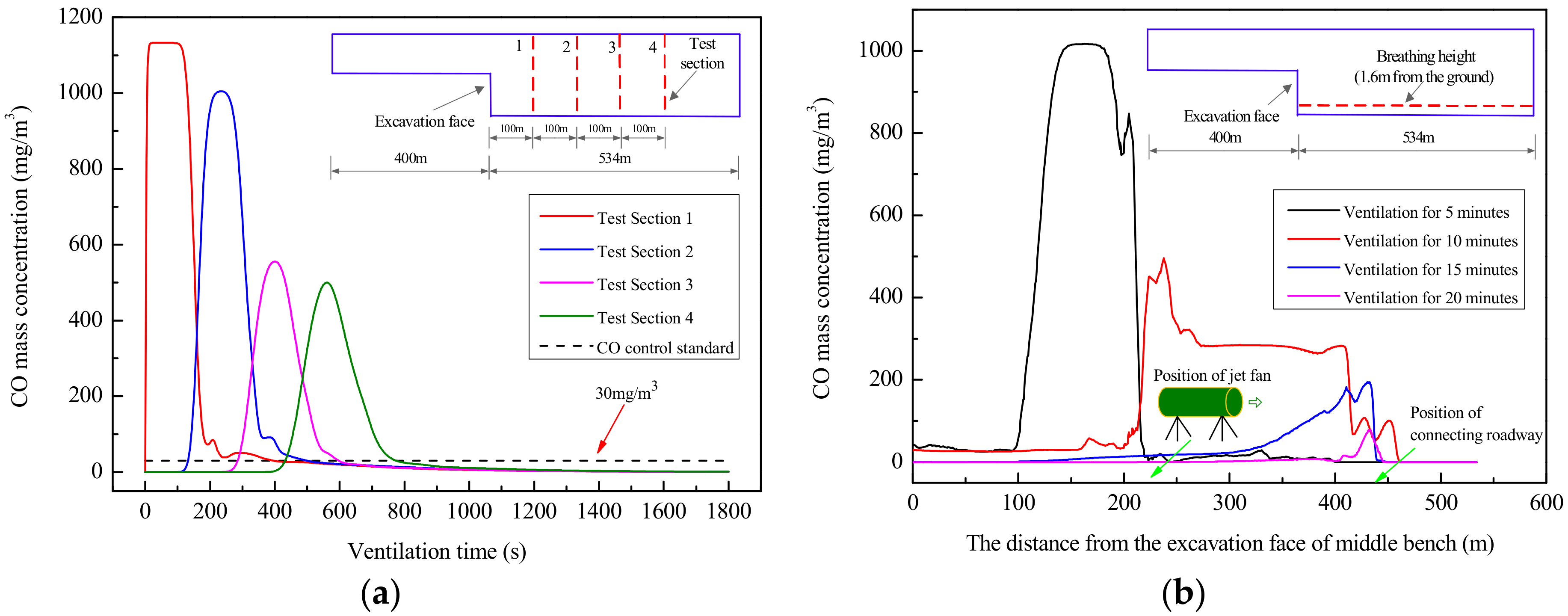
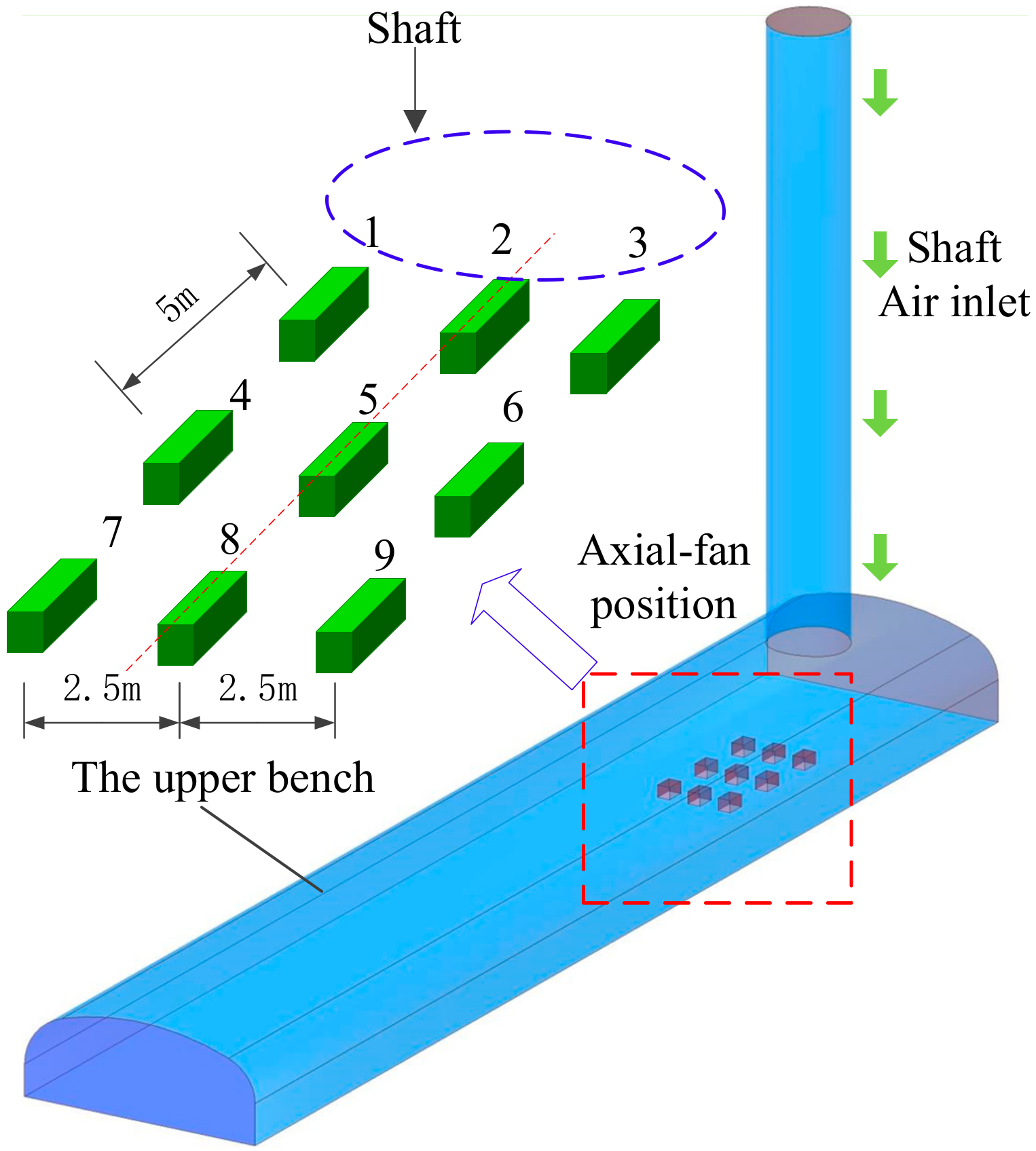
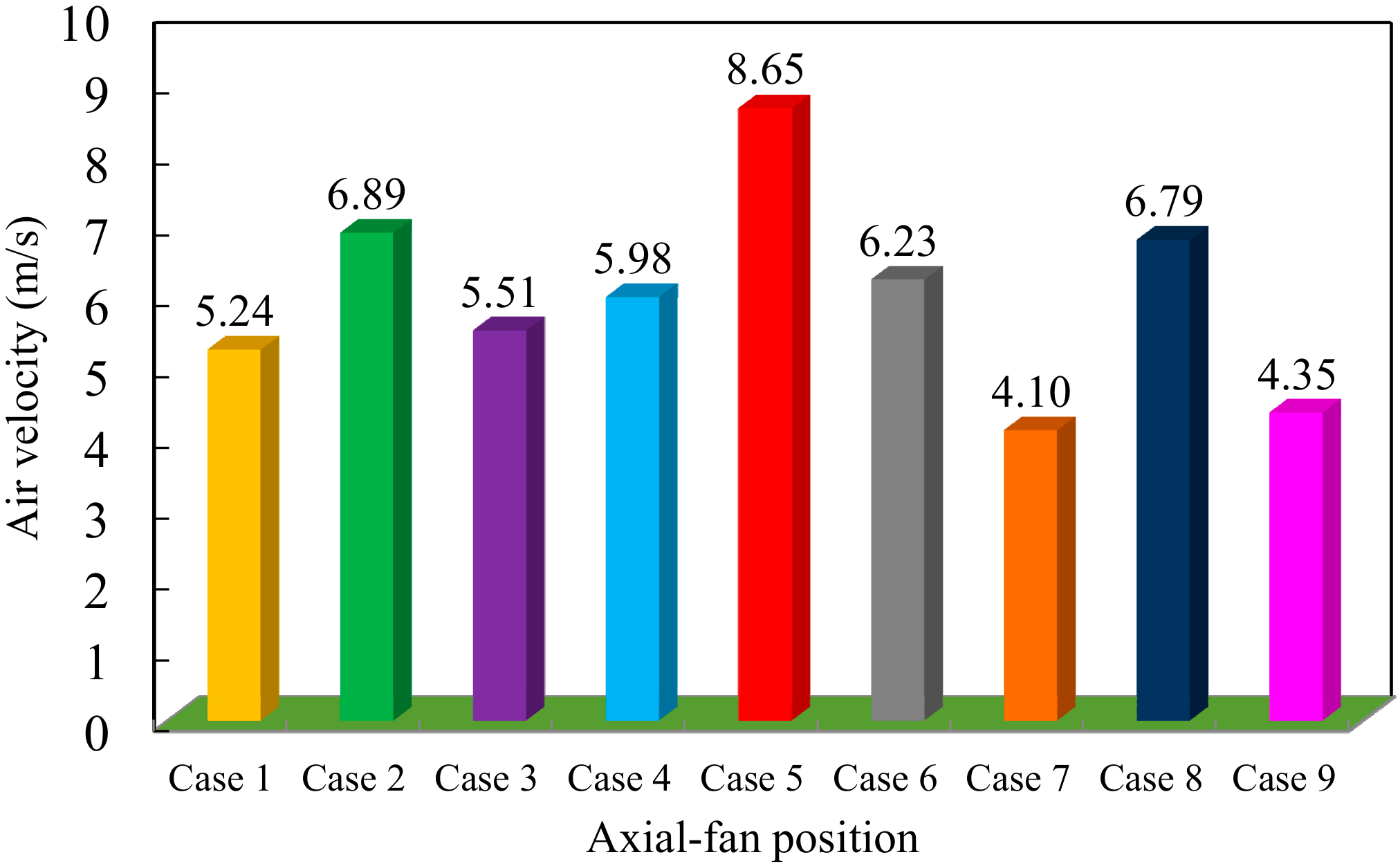

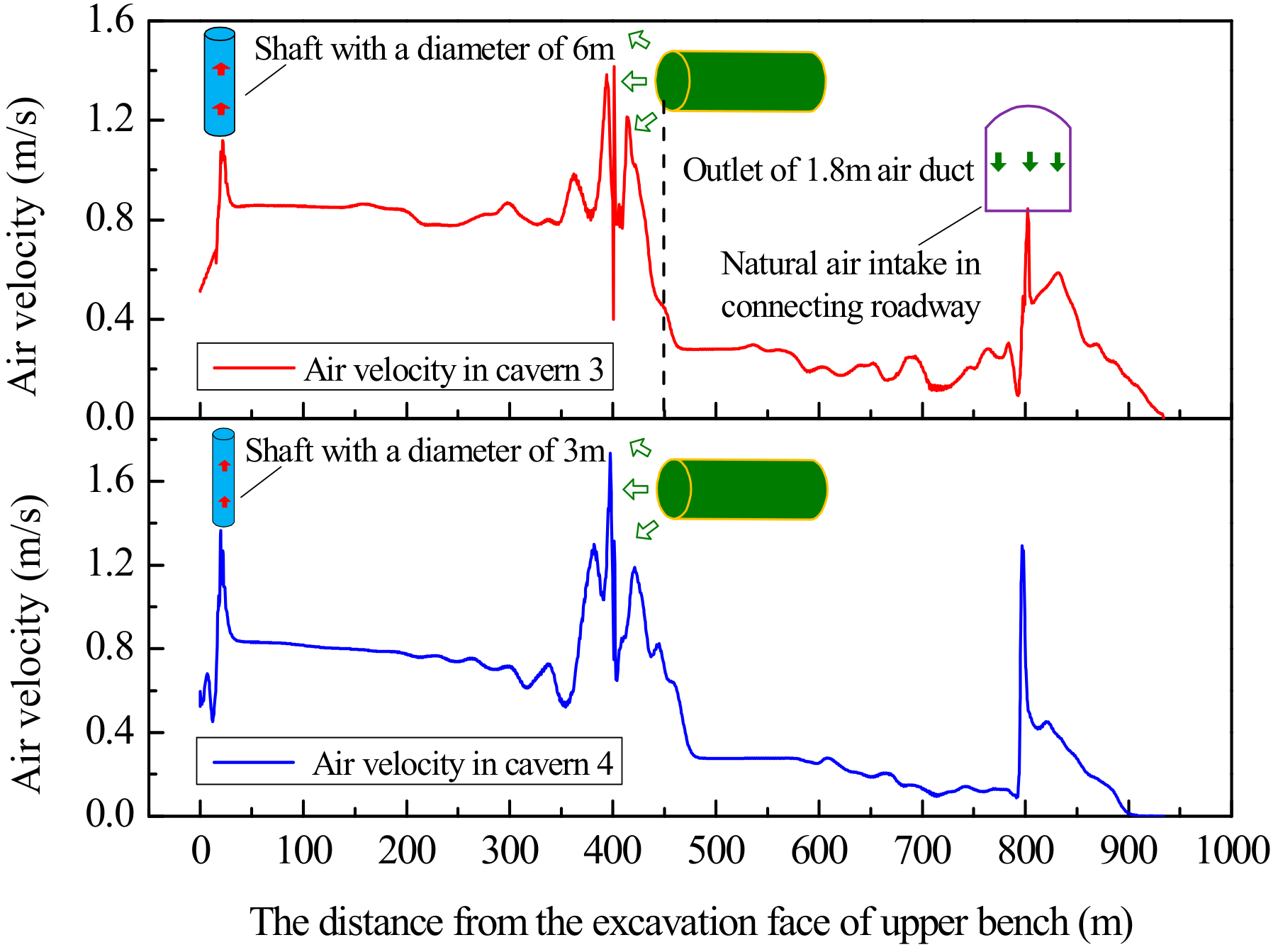
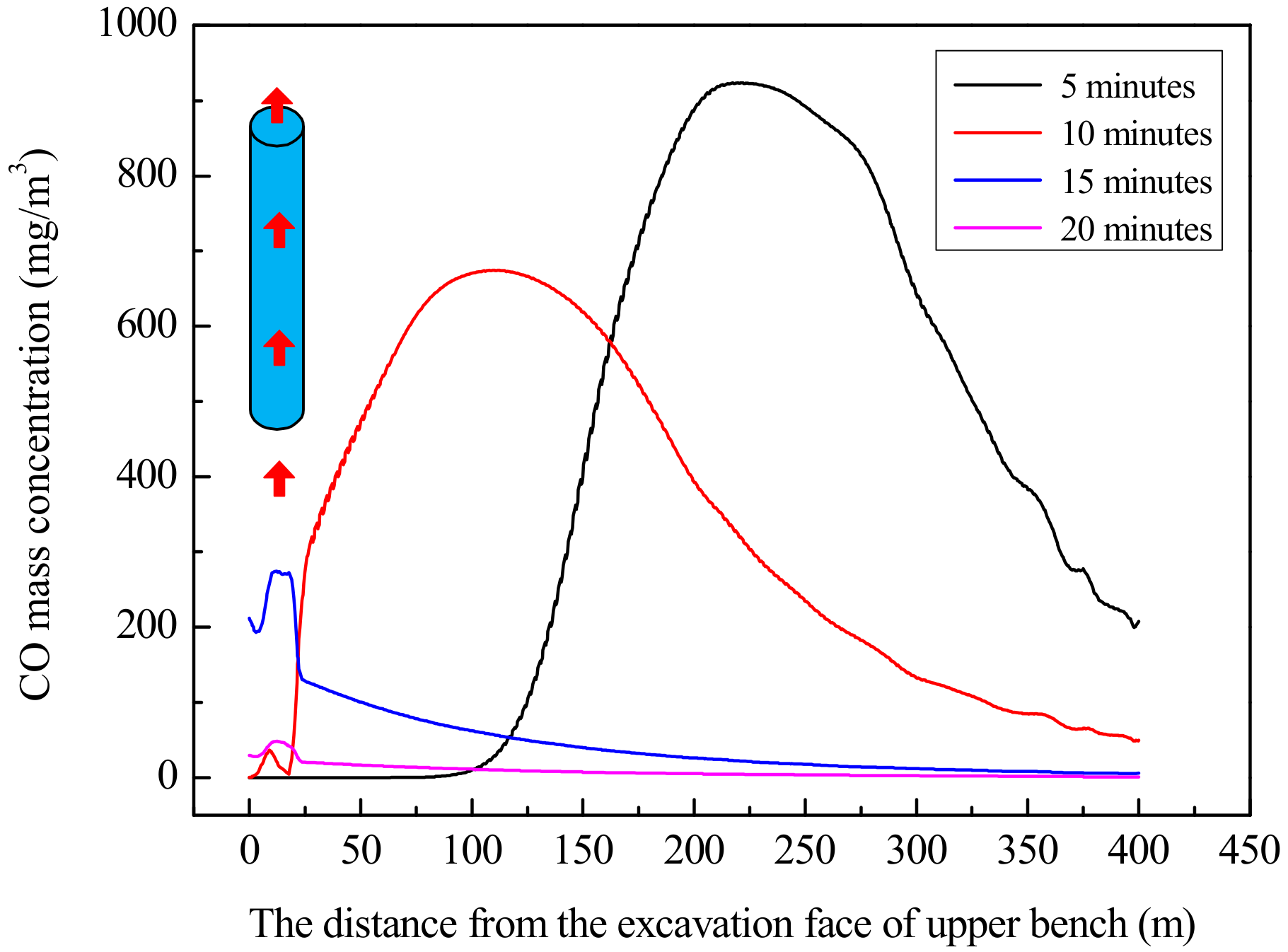
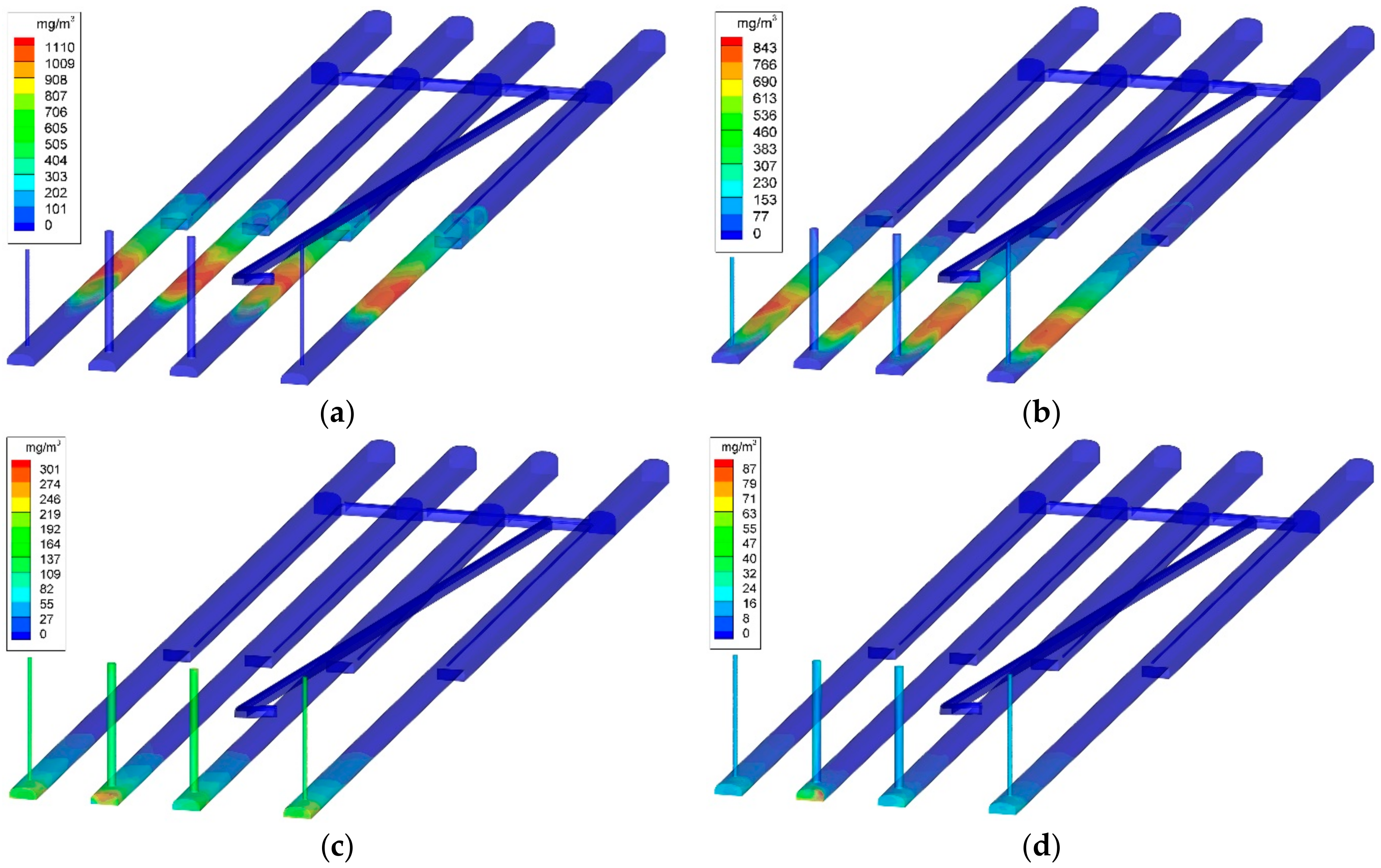
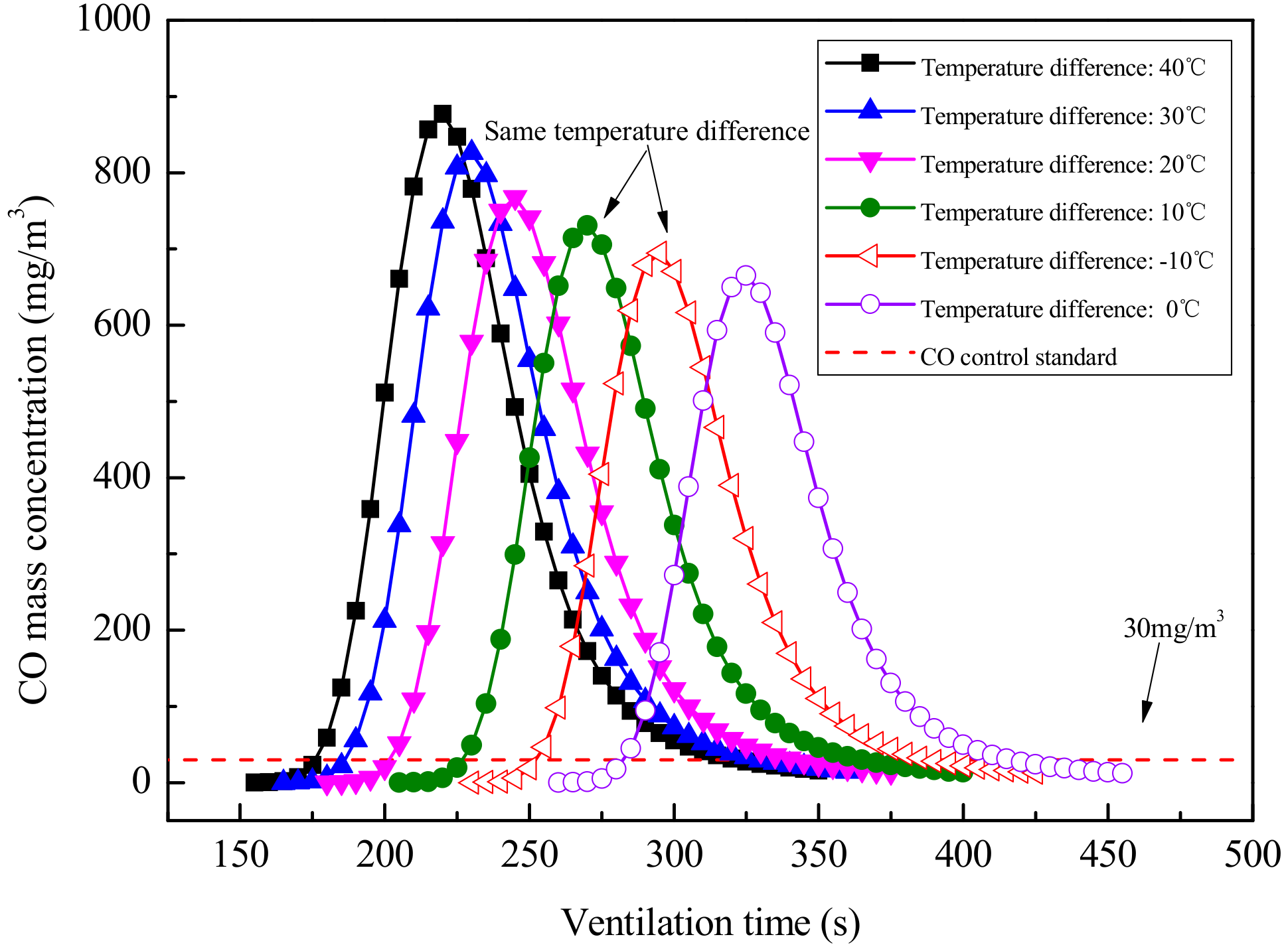
| Section | A (m2) | G (kg) | LOT (m) | The Amount of CO (m3) | C0 (mg/m3) |
|---|---|---|---|---|---|
| Upper layer | 135.1 | 320 | 79 | 12.8 | 1499.1 |
| Middle layer | 152 | 320 | 79 | 12.8 | 1332.4 |
© 2018 by the authors. Licensee MDPI, Basel, Switzerland. This article is an open access article distributed under the terms and conditions of the Creative Commons Attribution (CC BY) license (http://creativecommons.org/licenses/by/4.0/).
Share and Cite
Sun, J.; Zhang, H.; Huang, M.; Chen, Q.; Chen, S. Reasonable Paths of Construction Ventilation for Large-Scale Underground Cavern Groups in Winter and Summer. Sustainability 2018, 10, 3768. https://doi.org/10.3390/su10103768
Sun J, Zhang H, Huang M, Chen Q, Chen S. Reasonable Paths of Construction Ventilation for Large-Scale Underground Cavern Groups in Winter and Summer. Sustainability. 2018; 10(10):3768. https://doi.org/10.3390/su10103768
Chicago/Turabian StyleSun, Jianchun, Heng Zhang, Muyan Huang, Qianyang Chen, and Shougen Chen. 2018. "Reasonable Paths of Construction Ventilation for Large-Scale Underground Cavern Groups in Winter and Summer" Sustainability 10, no. 10: 3768. https://doi.org/10.3390/su10103768




